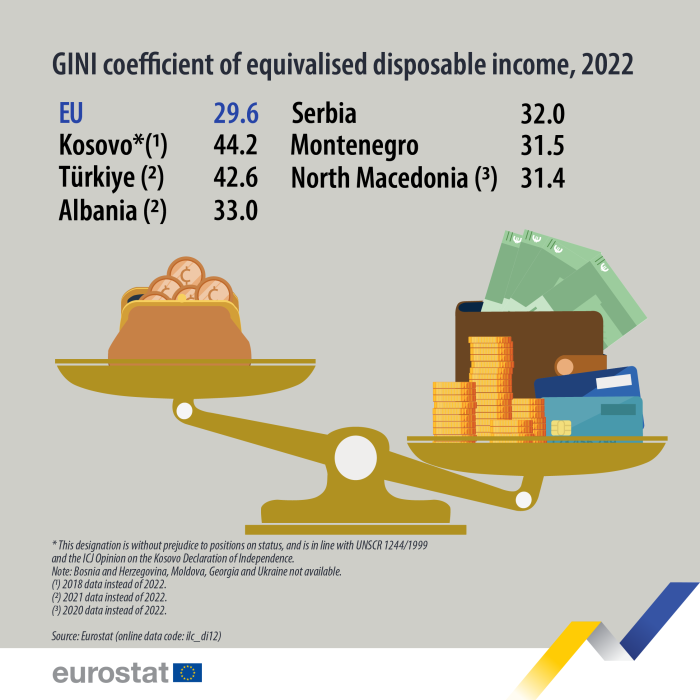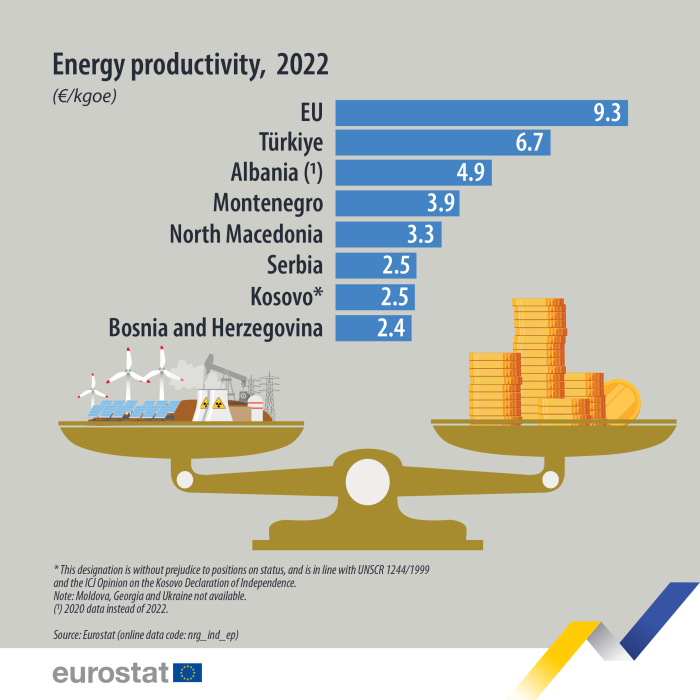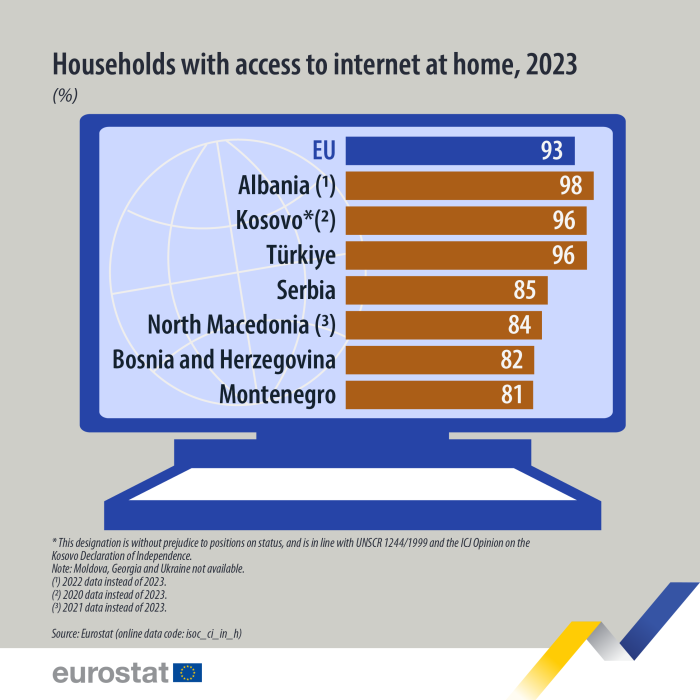Key figures for European Neighbourhood South countries
Data from May 2024. Planned article update: June 2025.
Highlights
In 2022, the population density of the candidate countries ranged from 46 inhabitants per square kilometre in Montenegro to 111 in Türkiye. In the EU, the population density was 109.
GDP per capita in the candidate countries was between €5 390 in Albania (2021 data) and €10 500 in Serbia in 2023. In comparison, it was €37 620 in the EU.
In 2023, the share of households that had internet access at home ranged from 81% in Montenegro to 98% in Albania. In the EU, 93% of households had internet access.
In 2022, North Macedonia was the only candidate country with higher unemployment for men than for women, with a difference of -0.8 pp. The highest gender gap was in Bosnia and Herzegovina, where unemployment was 7.4 pp higher for women than for men.
This article is part of an online publication. It provides information on six main topics for the candidate countries and potential candidate, compared with the European Union (EU).
Bosnia and Herzegovina, Montenegro, Moldova, North Macedonia, Georgia, Albania, Serbia, Türkiye and Ukraine are candidate countries, while Kosovo* has the status of potential candidate.
The new candidate countries, Georgia, Moldova and Ukraine, are now included in the set of articles covering the enlargement countries. For these articles, only data which are submitted to and validated by Eurostat's subject matter units following the same process as data from Member States, are used. For Georgia, Moldova and Ukraine, data for many areas are therefore not available yet. However, these countries are also presented in the Statistics Explained articles for ENP-East countries, which are based on data supplied by and under the responsibility of the national statistical authorities of each country on a voluntary basis. Consequently, because of the different data sources, this leads to inevitable differences in data coverage between these two sets of articles.
The article includes information relating to population density; gross domestic product (GDP) measured in € per capita; inequality of disposable income measured by the Gini coefficient; energy productivity expressed in gross value added (GVA) per kilogram of oil equivalent (kgoe); internet access of households, and; the gender gap with respect to unemployment.
* This designation is without prejudice to positions on status, and is in line with UNSCR 1244/1999 and the ICJ Opinion on the Kosovo Declaration of Independence.
Full article
Population density
Data on population density, measured in the number of inhabitants per square kilometre, are illustrated in Figure 1 for the candidate countries and the potential candidate and compared with the EU. Data were not available for Bosnia and Herzegovina and Kosovo.
In 2022, Türkiye had the highest population density among the candidate countries, at 111 inhabitants per square kilometre, and was the only candidate country with a higher density than the 109 estimated in the EU. Albania followed, with an estimated population density of 99 inhabitants per square kilometre, while the density was 91 in Serbia (2019 data instead of 2022), 74 in North Macedonia, and 46 in Montenegro (2021 data instead of 2022).
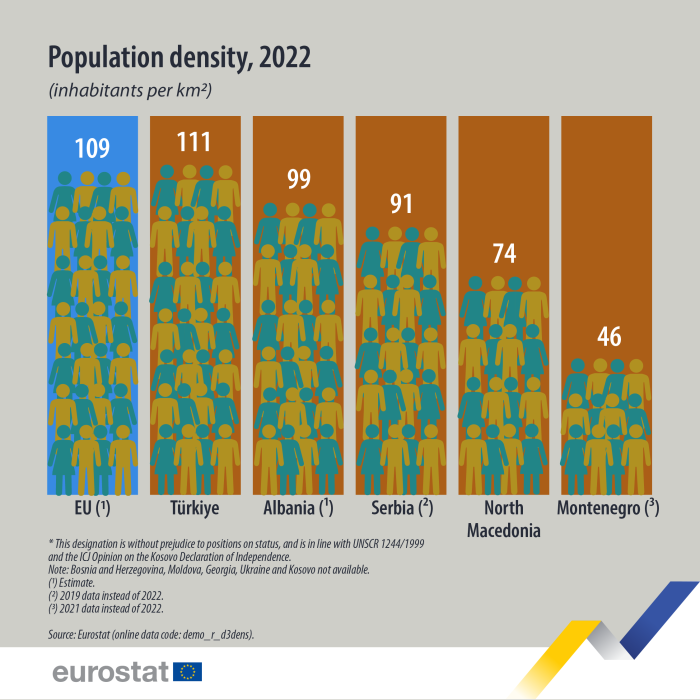
(inhabitants per km2)
Source: Eurostat (demo_r_d3dens), (demo_pjan) and (reg_area3).
Gross domestic product per capita
Analysis of GDP per capita (per inhabitant) removes the influence of the size of the population, making comparisons between different countries of different sizes easier and more meaningful. GDP per capita is a broad economic indicator that is often used as a measure of living standards.
Figure 2 shows GDP per capita at current market prices (i.e. in nominal terms) in the candidate countries and potential candidate and in the EU in 2023.
The highest GDP per capita among the candidate countries in 2023 was recorded in Serbia with €10 500 (provisional data), followed by Türkiye with €10 150 (2022 data). This represented slightly more than one fourth of the value in the EU, €37 620. In Montenegro, GDP per capita was €9 600 (2022 data), while in North Macedonia it was estimated at €6 440 (2021 data). The GDP per capita in Albania was €5 390, about seven times lower than in the EU.
The GDP per capita values in the candidate countries were relatively similar to each other, with the highest value close to double that of the lowest. In comparison, in 2023 the GDP in € per capita among the EU countries ranged from €14 580 in Bulgaria to €118 770 in Luxembourg, with the highest value almost eight times higher than the lowest.
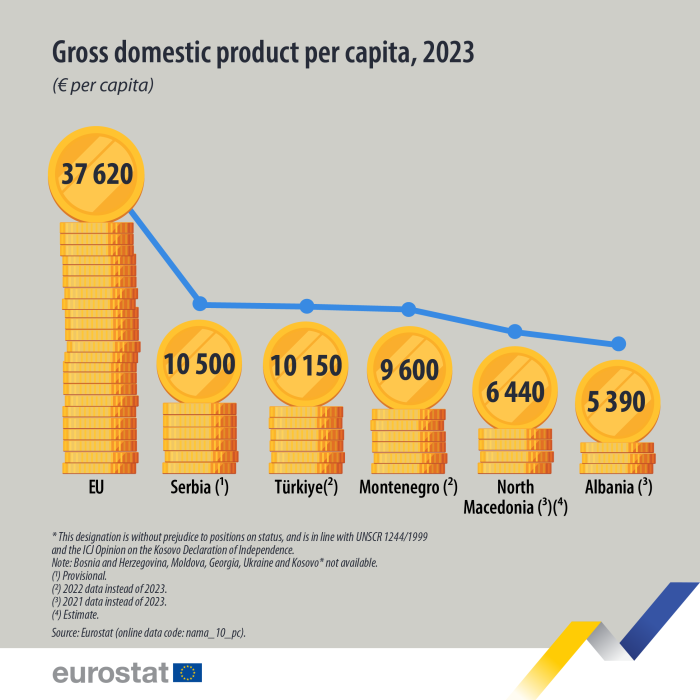
(€ per capita)
Source: Eurostat (nama_10_pc)
Gini coefficient
The Gini coefficient is a measure of income inequality. It shows the extent to which all incomes within the population differ from the average income: the closer the coefficient is to 100 the less equal are the incomes, while the closer the coefficient is to 0 the more equal they are.
In Figure 3, the Gini coefficient for 2022 has been calculated on the basis of the equivalised disposable income, i.e. the total income of a household, after tax and other deductions, that is available for spending or saving, divided by the number of household members converted into equivalised adults. Data were not available for Bosnia and Herzegovina.
The income inequality measured by the Gini coefficient in the EU, at 29.6 in 2022, was lower than in any of the candidate countries and potential candidate. Among these, the income inequalities were the highest in Kosovo and Türkiye, with coefficients at 44.2 in Kosovo (2018 data) and 42.6 in Türkiye (2021 data). Across the other countries, income inequalities were relatively similar to each other, with Gini coefficients at 33.0 in Albania (2021 data), 32.0 in Serbia, 31.5 in Montenegro and 31.4 in North Macedonia (2020 data).
Energy productivity
Figure 4 presents the energy productivity for 2022 in the candidate countries and potential candidate. It measures the amount of economic output produced per unit of gross available energy (GAE). Gross available energy, measured in kilograms of oil equivalent (kgoe), represents the quantity of energy products needed to satisfy all demand for energy products in a country.
The data presented reflect the energy efficiency and economic structures of these economies, and can be influenced by many factors, including technological advancements, shifts in the industrial base and energy policy.
The energy productivity of Türkiye was the highest among the candidate countries and potential candidate in 2022, with €6.7 per kgoe. Albania had the second highest energy productivity, at €4.9 per kgoe (2020 data). Montenegro had an energy productivity of €3.9 per kgoe and North Macedonia of €3.3. Serbia and Kosovo both recorded an energy productivity of €2.5 per kgoe in 2022, with Bosnia and Herzegovina having only a slightly lower energy productivity of €2.4.
The EU energy productivity was higher than that of all the candidate countries and potential candidate, with €9.3 per kgoe in 2022. This may suggest a higher energy efficiency or that a larger share of total gross value added is generated by activities that require less energy. Differences in price levels of output may also influence the calculation, although higher prices for output to a certain extent counterbalance higher prices for raw materials in the calculation of GVA.
Households with internet access
The data in Figure 5 presents the level of internet access at home among households in the candidate countries and potential candidate for the year 2023.
In Albania, 98 % of households had access to internet at home in 2022 (2023 data not available). Kosovo (2020 data) and Türkiye followed, both with 96 %. This was higher than in the EU, where 93 % of households were able to access internet at home. In contrast, 85 % of households in Serbia had internet access at home, a rate lower than in the EU. The same applied to North Macedonia, with 84 % (2021 data), and Bosnia and Herzegovina, with 82 %. With 81 %, Montenegro recorded the lowest rate of households with internet access among the candidate countries.
Unemployment gender gap
The unemployment rate is calculated for the economically active population aged between 20 and 64. The gender gap is defined as the difference between the unemployment rates for women and men, respectively, calculated as the unemployment rate for women minus that for men (measured in percentage points (pp) difference). Positive values indicate a higher unemployment rate for women than for men.
Figure 6 presents the unemployment gender gap in the candidate countries and potential candidate and in the EU for the year 2022. Data for Albania and Kosovo were not available.
In 2022, the unemployment rate for women was 7.4 pp higher than that for men in Bosnia and Herzegovina, the highest unemployment gender gap among the candidate countries. This was significantly higher than in any of the other candidate countries. The second highest gender gap was recorded in Türkiye, where the unemployment rate for women was 4.6 pp higher than that for men. In the other candidate countries, the unemployment gender gap was substantially lower, with gaps of 1.2 pp in Montenegro and 0.9 pp in Serbia. In comparison, the unemployment rate for women was just 0.6 pp higher than that for men in the EU. North Macedonia was the only candidate country where the unemployment rate for men was higher than that for women in 2022, with a negative unemployment gender gap of -0.8 pp.

(percentage points difference in unemployment rate by sex)
Source: Eurostat (lfsa_urgan).
Source data for tables and graphs
Data sources
The candidate countries and potential candidate provide data directly to Eurostat's subject units, responsible for the respective statistical areas; these data have been used in this article. This mechanism operates in the same way as Eurostat's regular data collection from EU Member States and EFTA countries. These statistics are also available free-of-charge on Eurostat's website.
While basic principles and institutional frameworks for producing statistics are already in place, the candidate countries and potential candidate are expected to progressively increase the volume and quality of their data and to transmit these data to Eurostat in the context of the EU enlargement process. EU standards in the field of statistics require the existence of a statistical infrastructure based on principles such as professional independence, impartiality, relevance, confidentiality of individual data and easy access to official statistics; they cover methodology, classifications and standards for production.
For more details on the specific surveys and data collections providing the data presented in this overview article, please consult the 'Data sources' section of the respective thematic articles for the.
Information concerning the current statistical legislation in the different statistical areas covered in this article can be found in the 'Legislation' section of the respective Dedicated sections on Eurostat's website (see under 'Dedicated section' in the direct access links at the bottom of the page).
Context
Eurostat has the responsibility to ensure that statistical production of the candidate countries and potential candidates complies with the EU acquis in the field of statistics. To do so, Eurostat supports the national statistical offices and other producers of official statistics through a range of initiatives, such as pilot surveys, training courses, traineeships, study visits, workshops and seminars, and participation in meetings within the European Statistical System (ESS). The ultimate goal is the provision of harmonised, high-quality data that conforms to European and international standards.
Additional information on statistical cooperation with the candidate countries and potential candidate is provided in the Statistics explained background article Enlargement policy and statistical cooperation.
Direct access to
- Enlargement countries — statistical overview — online publication
- Statistical cooperation — online publication
- Population and demography
- National accounts and GDP — online publication
- Living conditions in Europe - income distribution and income inequality — online publication
- Energy statistics - an overview — online publication
- Statistical books/pocketbooks
- Key figures on enlargement countries — 2019 edition
- Key figures on enlargement countries — 2017 edition
- Key figures on the enlargement countries — 2014 edition
- Digital economy & society in the EU — a browse through our online world in figures — 2018 edition
- Factsheets
- Basic figures on the candidate countries and potential candidates — Factsheets — 2023 edition
- Basic figures on Western Balkans and Türkiye — Factsheets — 2022 edition
- Basic figures on enlargement countries — Factsheets — 2021 edition
- Leaflets
- Basic figures on enlargement countries — 2019 edition
- Basic figures on enlargement countries — 2018 edition
- Basic figures on enlargement countries — 2016 edition
- Population change - Demographic balance and crude rates at national level (demo_gind)
- Population (demo_pop)
- Energy (nrg), see:
- Labour market (labour), see:
- Southern European Neighbourhood Policy countries (ENP-South) (enps) (ESMS metadata file — enps_esms)
- Population (ESMS metadata file — demo_pop_esms)
- National accounts (ESA 2010) (na10) (ESMS metadata file — na10_esms)
- Energy statistics - quantities (nrg_quant) (ESMS metadata file — nrg_quant_esms)
- Income and living conditions (ilc) (ESME metadata file — ilc)
- LFS series - detailed annual survey results (lfsa) (ESMS metadata file — lfsa_esms)
